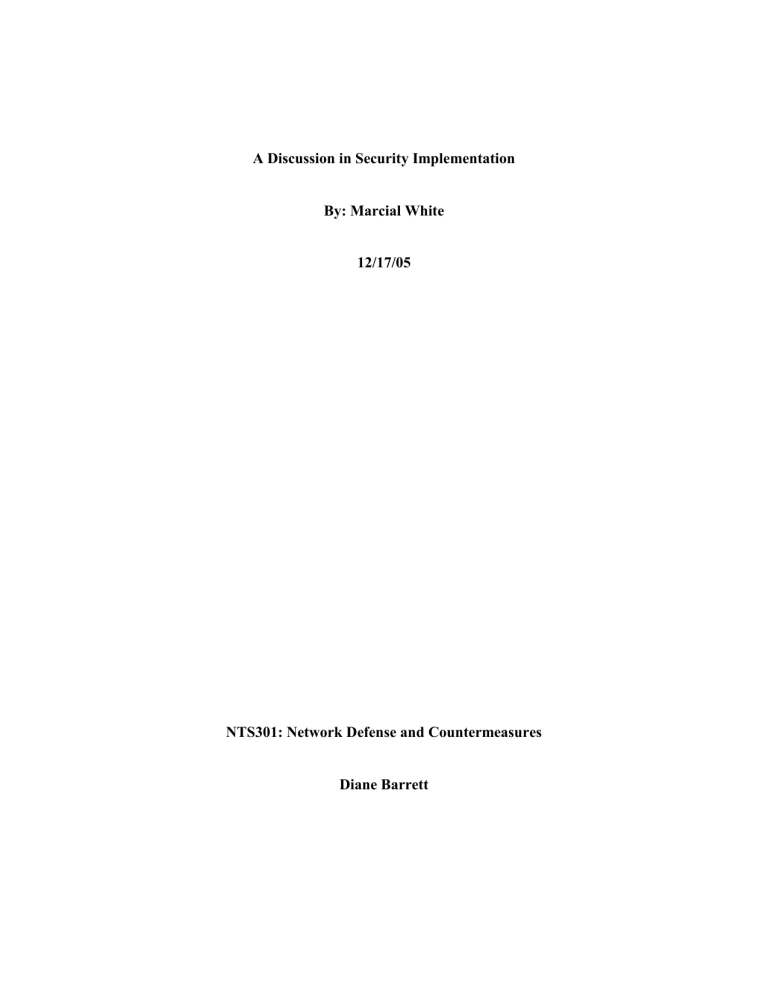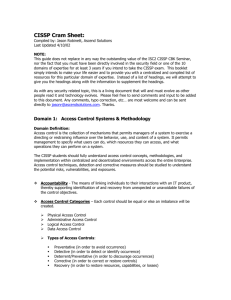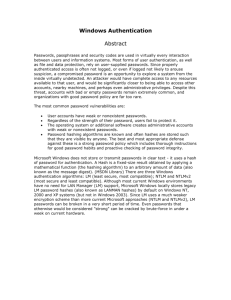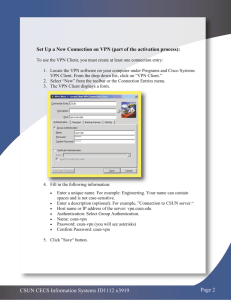Network Diagram

A Discussion in Security Implementation
By: Marcial White
12/17/05
NTS301: Network Defense and Countermeasures
Diane Barrett
Network Diagram
The Diagram
Computer networks have become to robust in function that it is impossible to be able to emulate a network without knowing what services need to run within the network. For example, a network for a company that specializes in web development and hosting is going to have a very different network than a company that specializes in payroll processing. Therefore, this network diagram is only a representation of key concepts that should be employed when developing a network.
From the service provider, a Debian 3.1 router on a Dell PowerEdge 1855 forwards packets through an
IDS sensor to dual firewalls for load balancing purposes. The DMZ has been outfitted with a separate machine for some of the more common serving services, all hosted on Debian 3.1 machines. The internet connection is routed from the firewalls to the first LAN, the Local Branch East. This is just a designation for a logical separation in networks for load balancing purposes, not necessarily suggesting they are at disparate locations. In that case, a high speed optical trunk would be considered to join the two networks for resources. Between the two LANs is an interface pointing to resources for the network, designated in this case by file servers. This local area network is adjacent to the back up LAN for efficiency reasons. All of the snort sensors report information back to the IDS processor in the DMZ.
To expand this network, the specific server that the network will perform is a necessary piece of information. To simply recreate this network in another city, an optical trunk could be constructed physically and securely connecting the file server LANs.
Organizational Change Policy
Managing changes is an essential element of providing a robust and efficient Information Resources infrastructure. The purpose of this policy is to structure changes predictably such that clients and staff can plan
accordingly. This policy applies to all users of the network, local and remote. Failure to follow the Change
Management Policy may result in disciplinary action, which may include termination.
Change Management Policy
Any and all changes to the Information Resources resource are subject to the Change
Management Policy described here, including but not limited to: o Operating Systems o Computing Hardware o Networks o Applications
Any significant differences in environment and climate will be reported to the Information
Security manager, and the facilities manager.
A Change Management Committee, appointed by the IS decision makers will meet regularly to analyze change requests, and to ensure that all change reviews and mandates have been performed satisfactorily.
All requests for changes will be submitted via the change request form available on the employee intranet, for both scheduled and unscheduled changes.
All changes must be approved by a majority vote the Change Management Committee before implementing the mandate.
A change review must be conducted in all outcomes of a change proposal.
A change log must be updated at the time of the approval of the mandate.
Firewall and IDS Changes
Networks are constantly changing and should always be examined for weaknesses. When vulnerabilities are identified and successfully exploited, it is dubbed a “zero day”. This is a term coined to note that the vulnerability is brand new, following the coding mantra of absolute zero being nothing –otherwise known as
zero. Because networks are so dynamic, it is important to plan for change when developing the policy, and the firewall and IDS rules. The first step is to document that there is an issue, and that the organization is taking steps to address the need or concern. The administrator should be as detailed as possible in the documentation for any changes to network configuration or policy manipulation.
If an exploit is released that has noticeable signatures or attributes illustrating malicious behavior, altering\appending rules to the IDS and firewall will negate the possible misuse. Before any of the production equipment (production equipment being any hardware or software that is running and actively service information and resources to local and\or remote hosts) is altered, the change should first be implemented in a closed network dedicated to testing configurations. This is known as a test bed. A test bed is a full working copy of the production environment, which will be able to accurately return information on how a system change or configuration change effects the rest of the network that the service is running on. Often times, changing configurations or adding or removing hardware will result in the system or network to become unstable, sometimes losing bits of data, and sometimes completely impeding normal operation.
To implement a change to a firewall or IDS rule, the provision must first be compared to each of the entries in the existing rules to prevent duplicate rule entries. When it is understood that the proposed rule is in fact unique, the rule is applied to the “testbed” environment, where all of the tasks of all of the users of the network are tested for compatibility. The average development and test time for a similar project is approximately 5-8 months depending on the control. However, in the case of IDS and firewall reconfiguration, there are other techniques that can be utilized to ensure a smooth transition.
When implementing a change in policy or software configuration, there are two main considerations to keep in mind. First, blocking traffic at a firewall or reporting traffic with an IDS will take all traffic that matches the information used in comparison. It would be wise for an administrator to capture some traffic that matches the rule that is to be added to the firewall or IDS to see what else is going on in the network. It’s possible there is another program or utility that utilizes similar signatures that would likely be disabled. This may also provide insight to unintentional traffic, to which the administrator can deal with accordingly. Second, not all software is
written with compatibility in mind. It’s important to be current with project development errata to understand the legacy and zero day bugs. Because of this, it’s important for an administrator to test run all of the software used within the network.
When all of the controls have been properly tested and implemented, the documentation should reflect a successful implementation, including a detailed tutorial for every step to fixing the problem. It is not uncommon for tasks to be repeated, and it is unreasonable to assume the administrator that implements a control the first time will always be around to assist with said (or similar) implementations in the future.
User Impact of Changes
All changes within a network are going to affect the end user in some respect. At times this effect may be nothing more than a mere nanosecond delay in processing a web page, but can also be as severe as completely eliminating functionality or as tedious as reading and agreeing to a service agreement. All policy changes should be reflected to the users in regularly scheduled security awareness meetings, and all interim policy changes should be communicated to all users at least via e-mail or memorandum.
The exact impact an alteration to policy will have on the network’s users is relatively nebulous, until the alteration is defined. For example, a simple change in policy that results in a rule like “all MAC addresses must be logged and registered in order to access the internet” should be a seamless implementation, where the user is simply alerted of the change, and they never notice a decay of accessibility or service. Conversely, if a rule like
“no peer to peer instant messenger programs are allowed” was implemented on a network that previously approved such traffic, users would be directly affected, and additional training and support should be available to ensure the users productivity.
As security is an ongoing process, so is optimizing network resources. It is important to have all incidents involving user input on policy changes documented for self reflection. It is not uncommon for the decision makers of a company to enforce a policy revision or service limitation that may not be of the most
profitable decisions for the long run. User input will allow an administrator to gather facts regarding suggestions and better steer the decision makers in the future.
VPN Gateway Implementation
Any extension of services will certainly require that policy be addressed and altered as necessary. As network use approaches capacity, actions must be taken to accommodate additional users. Adding functionality like a VPN gateway should never be taken lightly and must proceed with rigorous security testing to ensure the highest level of success. Every addition to a network that broadens scope should be handled delicately, as every control providing the user greater accessibility also provides malicious users an additional route into the network. Because there is no one implementation methodology that would cover security for every scenario, each control will have to be researched individually and a comprehensive methodology implementing that specific control should be created and documented for future reference.
For example, adding VPN gateways to a network can be much more difficult than simply rebuilding the network with the additional VPN support. Unfortunately, this is usually not an option as it requires more network downtime (and thus lost productivity) than simply building on the existing network. VPNs are broken down into domains, and adding a gateway to a domain that was created with a single point of entry included within the domain could potentially result in overlapping IP addresses, making it difficult to efficiently route packets. Examining the VPN topology can provide helpful insight in how to go about implementing an additional gateway. A full mesh VPN implementation provides the best accessibility, and is preferred over the star VPN configuration because it avoids instituting a single point of failure. Performing a full scale penetration test on the addition to the network will always provide the administrator with the information they don’t want to learn about from a malicious user, and as they say: better safe than sorry. Narrowing the test to one specific protocol or application will speed the process, and with an unlimited budget this type of test is essential to securing a network.
Access Control List Changes
There are also configuration changes within a network that does not necessarily expand network scope, but still presents a security risk. Access control lists (ACL) are the set of permissions that specify conditions that must be fulfilled in order to use a resource that the ACL is protecting. Logically, a mis-configured ACL can most definitely result in a breach of security. How an administrator goes about altering ACLs depends on the implementation. Microsoft Windows NT/2000, Novell's NetWare, Digital's OpenVMS, and Unix-based systems are some of the operating systems that use utilize ACLs, and each implementation varies. However, they all provide the same basic functionality of dictating permissions to resources.
ACL administration is sometimes a confusing task, but is crucial to the security of the network. The best way to successfully implement ACL updates is to research and understand how the specific implementation works. Many implementations break down permissions into octal coordinates, six digits that represent no permissions through full permission for the three categories of users: owners, groups, and everyone else. Tools have been developed to double check ACL administration, and have thus become an essential tool for networking administrators. Cisco offers the source to a program written to interrogate ACLs to ensure they are syntactically correct. Windows ACL administration can be aided with the proprietary tool “AdvancedChecker”, a scripting language for Windows NT, 2000, XP and server 2003 and provides a simple system to check, set, and enforce network-wide security and intrusion detection policies. Once an ACL is developed (or altered) it should be double checked by one of these scripts, reviewed by a trusted peer for advice, and implemented and tested in the test bed environment prior to ACL deployment.
Strong Password Policy
All the users within a network are trusted and granted access to certain resources. The average user will not likely understand that they are the frontline for security of the organization. For example, every user is issued a username and sometimes offered to create their own password so that they can remember it. Because network security is somewhat of a new concept to some organizations, password security has never been addressed. Passwords are a good step toward good security, but the security is only as good as the implementation. Often times the problems and vulnerabilities that make using passwords inadequate for
authentication and protection of resources are realized as weak passwords and insecure storage of the information, which are in turn subject to brute force and dictionary attacks, and social engineering attacks.
In response to the realization of the necessity and proper use of passwords, a system has been devised to assist users in creating strong passwords protecting against hacking attacks, and creating passwords in such a way that it is easy to remember, providing a form of control against social engineering attacks. This system has been dubbed “Simple Formula for Strong Passwords” (SFSP), and should be utilized in any network that requires a username and password for authentication and protection of assets.
SFSP relies on a password development algorithm that allows users to select information that is easy to remember (i.e. birth or wedding date, first name or favorite food), combined with input rules that dictate where certain information appears in the password. To illustrate SFSP, a user would select a secret number (12345), a secret word (jungle), and create a rule (numbers are arranged in defending order). The result is “5j4u3n2g1le”, a password that relies on a dictionary word and a simple number string but is not vulnerable to dictionary attacks, and is less likely to be memorized by prying social engineering eyes. Some systems will allow users to use symbols in their password, which will contribute to preventing a successful brute force attack. Other variations are also available like alternating capital letters, enhancing and appending rules like “always capitalize the third letter”, and “increase the sequence by one character at every forced password reset”. When SFSP is utilized properly, password security can be maximized.
Using passwords are an essential part of security policy, and documentation should be updated to reflect the use of SFSP. But including SFSP in documentation is not enough: security awareness training becomes required to ensure proper utilizations of this method. Without training, users are likely to interpret the methodology incorrectly, negating the security gained by using the methodology in the first place.
Network Defense
Network defense is a never ending battle between good, evil, and all of the shades of grey in between.
Security is never absolute, and constant scrutiny and borderline paranoia are key elements to maintaining a
secure network. Through years of trial and error, reactive patching (i.e. “putting fires out”), philosophical debate, and organized brainstorming, the security industry has produced three main goals of security.
Confidentiality, Integrity, and Availability, often referred to as the CIA triad, compose the essence of network security. The need to authenticate a user, and the need to provide non-repudiation are addressed with the CIA triad, but are noteworthy as they have become key concepts in security.
Authentication
The act of authenticating a user is essential to security. This is the process that a user must follow in order to prove to the resource (which is a computer by the way) that they are in fact allowed to perform certain actions on that resource. There are many controls in place that reinforce authentication, like using usernames and passwords, using smart cards, and using biometric devices like retinal scanners and finger print scanners. Every possible action a user can do with a computer is done so through authentication. When you turn on a computer, you enter a username and password. If you are not required to, the computer assumes you are a user that has specific permissions to resources, even though you were never prompted.
Everything from browsing the internet, sending e-mail, and connecting to a network via VPN is conducted after the user has been authenticated. The lack of authentication (or rather, falsely issued authentication) is the source of a majority of network security. Operating systems and the software run on operating systems will attempt to authenticate users.
Non-repudiation
Authentication deals with making sure the user is who they say they are, but non-repudiation ensures the user that they are talking with someone who is who they say they are. Kerberos is an authentication mechanism that provides a method of non-repudiation. PGP is a method of encryption that provides a way for only intended users to read your message, a form of non-repudiation.
Confidentiality
This refers to the quality or state of disclosing resources and data to unauthorized. Confidentiality is compromised when sensitive data has been transmitted or otherwise “sniffed” and is no longer only in the hands of the users intended. This concept is preserved with certain controls like Kerberos, providing a mechanism for authentication and non-repudiation, and policies like proper document disposal.
Availability
Availability can be defined as the need to provide access to authenticated users that have already established credentials required to access a certain resource. In this sense, availability provides a way for an authenticated user to access a resource without obstruction or interference, and to receive the data from the resource in the required format. This aspect of security is dependant on authentication, which is attainable through controls like Kerberos and PGP.
Integrity
Keeping in mind that security is about protecting information that is stored in a way that can be manipulated, Integrity addresses the fact that information is useless if it’s been tampered with. This concept of security outlines the fact that information is the asset that we seek to protect, and that the quality of the data must remain in a state of being whole, complete, and uncorrupted. Information in this case can be data stored on a server, but it can also mean information disclosed in an email. Integrity of the data can be reinforced by encrypting the data in storage, creating multiple backups and storing them at physically disparate locations, and by properly protecting physical assets like computers and removable storage devices. Email integrity can be ensured through PGP, and utilizing strong passwords so that email accounts are not compromised.
Bandwidth
Because all of the packet filtering routing machines in the network are going to be Debian 3.1 machines,
I will have the capability to run Divert Sockets to copy all traffic that goes through the router to a third
interface, connected to a machine dedicated to logging. These logs will be analyzed using the bar chart log analyzer “packetchart.pl” available at http://www.xazompampas.gr/unix/ , and traffic will be observed and shaped accordingly.
Memory
In light of the recent memory vulnerability posted at eEye Digital Security’s website located at http://www.eeye.com/html/research/advisories/AD20051011b.html
, all Windows machine on the network are required to have Service Pack 2 installed. This problem does not exist for the Linux machines employed throughout the network as servers.
Storage
We will make use of Microsoft’s extensive research into the data back up and redundancy by using a
Quantum DPM5500 disk based backup solution, with integrated tape migration. The disks will be arranged in the Towers of Hanoi configuration, to accommodate for the need to both store data for long periods of time, and to address the cost of keeping such data for a long period of time. There will be monthly scheduled tape copy backup service to store copies of the data in an off site facility.
Top 10 Resources
1) Dark nets ( http://www.cymru.com/Darknet/
2) Divert Sockets ( http://www.faqs.org/docs/Linux-mini/Divert-Sockets-mini-HOWTO.html#ss6.4
)
3) Tool resource ( http://www.lifehacker.com/ )
4) Tool resource ( http://sourceforge.net/ )
5) Vulnerabilities list ( http://www.securityfocus.com/ )
6) Vulnerabilities list ( http://nvd.nist.gov/ )
7) Standards documentation ( http://csrc.nist.gov/pcig/index.html
)
8) Linux security ( http://www.linuxsecurity.com/ )
9) Securing Debian manual
( http://www.debian.org/doc/manuals/securing-debian-howto/index.en.html
)
10) NSA Linux kernel information ( http://www.nsa.gov/selinux/ )





